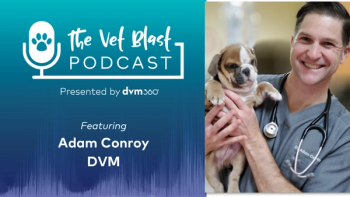
Animal cruelty: What's your responsibility?
Defining your role and responsibility in cases where violence against animals can lead to violence against people
Not long after Dr. Patricia Feeser bought her practice in Greenville, N.C., a client asked her to euthanize an old dog. She complied without thinking too much about it. While not the most enjoyable part of the job, the procedure was routine. A few months later, the client's wife came in with a new pet—and two black eyes.
Startled by the woman's appearance, Dr. Feeser probed for information as tactfully as she could. She learned that the old dog she'd put to sleep earlier had actually belonged to the wife, and the euthanasia had been her husband's idea of punishment. He had purchased a Pomeranian for her as a replacement, but the new dog suffered from multiple congenital disorders. Dr. Feeser did her best to treat the pet and educate the client, and soon they were on their way.
An hour later they were back, and this time the dog had two broken legs. The husband had become angry and taken out his rage on the pet—not an unusual chain of events in abusive households, as Dr. Feeser would eventually learn.
This incident motivated Dr. Feeser to start down a path she has been on ever since: investigating animal cruelty, educating people about the link between animal abuse and domestic violence, and providing resources for people who want to leave abusive situations but who fear for their pets' safety. "We've found that victims often won't leave because they know their pets will be abused if they do," she says. "The abuser uses the animal to manipulate the victim."
Providing a haven
Dr. Feeser established a program called PetSafe, modeled after a program at Purdue University that cares for the pets of domestic violence victims when they leave their abusers and enter shelters or other assistance programs. She contacted local officials and a domestic violence shelter and began taking in the pets of abuse victims, keeping them at the clinic until more permanent arrangements could be made. She provided a physical exam and any necessary vaccinations for these pets.
"This was my first introduction to law enforcement," Dr. Feeser says. "I contacted the first responders—the officers who go out on calls—to let them know the service was available. And I constantly reeducated them because of the high turnover in that group."
She also began investigating animal cruelty cases for the county. One memorable incident involved a cat that had had a firecracker inserted into its rectum and been set on fire. When Dr. Feeser contacted the city attorney, she refused to prosecute the case. "She said, 'I can't win with child abuse cases, let alone animals,'" she says. But by that point Dr. Feeser had developed a relationship with the sheriff's department. "They said, 'Give it to us. We'll investigate it.'"
Eventually the press caught wind of the story, including the fact that no animal cruelty case had been brought to court in local history. Public awareness grew, and although this offender was never caught, the community made the issue a priority from that point on.
Dr. Feeser has recently purchased a practice in Rio Rancho, N.M., where she's establishing another PetSafe program—this time as a network of anonymous foster homes. "We've already had a lot of inquiries," she says.
A frightening link
Diane Balkin, senior deputy district attorney in Denver, has been prosecuting animal cruelty for the last five years. She says law enforcement is waking up to the reality that pet abuse often coincides with child abuse, spouse abuse, and elder abuse. While five years ago officers in the Denver area might have made one animal cruelty arrest a year, now they make five or six.
Balkin says her goal and that of the officers is to be proactive rather than reactive. "We want to get these offenders before they can progress to worse cases of mutilation and torture—against animals or people," she says. "In serious cases, the best way to protect society is to lock the abusers up."
If you're suspicious
Balkin lectures to various organizations about animal abuse and human violence, and she says law enforcement groups can be skeptical. "They'll sit in the back and joke and say, 'We're here to protect people from rapists and murderers. Why are you wasting our time with this?'" Balkin says. "But I use definitive examples of how one crime leads to another, and at the end they come up to me and say, 'I had no idea about any of this.' They get it."
Balkin says there are three aspects to confronting the problem of animal cruelty.
• Education: raising public awareness of the issue and its many ramifications for the community.
• Intervention: protecting animals—and often their owners—from abuse.
• Collaboration: agreement and cooperation among law enforcement, humane and aid organizations, prosecutors, and veterinarians.
Balkin says a veterinarian's involvement is often crucial to obtaining a conviction, especially in felony cases. Meticulous records and detailed documentation of the injuries and cause of death, including photos, can make the difference in whether an abuser goes to jail (see "If You're Suspicious," left).
"Years ago it was thought that people who abused children wouldn't take them to the pediatrician, but now we've found that's not true," Balkin says. "It's the same with animals. Veterinarians have thought that animal abusers wouldn't bring them in to the clinic, but they do."
James Julian Valdez (inset) threw his girlfriend's 7-week-old kitten against the wall during a violent domestic argument. The kitten suffered massive head injuries and was humanely euthanized after this photo was taken. Faced with a veterinarian's documentation, the defendant pleaded guilty to aggravated cruelty to animals, a felony in Colorado.
Recently an arrest warrant was issued for a Denver-area man who had broken the legs of two cats belonging to his girlfriend. "That case came in to our office through a veterinarian," Balkin says.
What you can do
Veterinarians who want to confront animal abuse in their community can do so in several ways, say Balkin and Dr. Feeser. An important first step is to develop a relationship with the local police. You need to know who to call if you suspect that a patient is a victim of cruelty. All 50 states have laws against animal abuse, and most have legislation making certain cases felonies.
Dr. Feeser says that it's important to give officers and prosecutors what they need to obtain a conviction in court. That means a clinical, unemotional assessment of the situation and detailed medical records—not ranting and raving. "Police officers and sheriff's deputies deal with armchair quarterbacks who criticize everything they do," she says. "I can get absolutely horrified and irate about something, but going off on the animal control officer isn't going to help. I have to find a way to make it work."
Another way to get involved is to establish a program like PetSafe, which cares for pets when victims leave an abusive situation, or find out if such a program exists in your community. If you want to start one, the first step is to contact your county manager or city mayor; he or she will know who your primary contacts would be to get started. (Visit
However, Dr. Feeser says she hasn't sensed willingness on the part of the veterinary community to confront this issue. When she set up the PetSafe program in Rio Rancho, not one veterinarian volunteered—and she doesn't know why. "Law enforcement is starting to understand that there's a huge connection between animal cruelty and domestic violence," she says. "But I'm not seeing that same sense of responsibility from veterinarians."
Two possible concerns that practitioners might have—the time commitment and potential safety issues—are not factors for Dr. Feeser. She spends about two hours a month on her animal cruelty work, and the anonymity of people involved is carefully protected.
"We help animals all day," Dr. Feeser says, "but if we can help owners as well, that's veterinary medicine at it's best. That's what we're supposed to be doing."
Balkin agrees. "Collaboration is important," she says. "If you work on creating a relationship on the front end, you're going to know who to call when that emergency case comes in in the middle of the night."
Editors' Note: Diane Balkin is willing to conduct individual seminars in veterinary practices to help them prepare to confront—and lessen—animal abuse. E-mail her at
Newsletter
From exam room tips to practice management insights, get trusted veterinary news delivered straight to your inbox—subscribe to dvm360.




